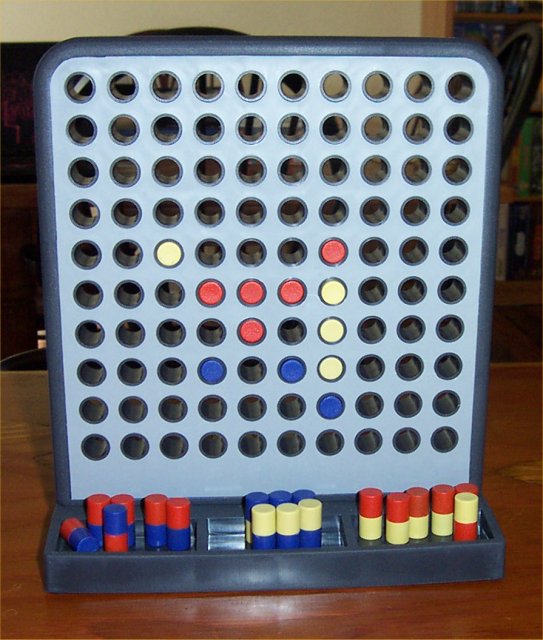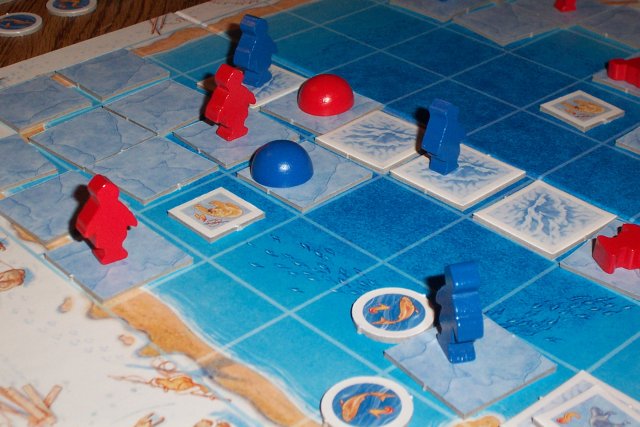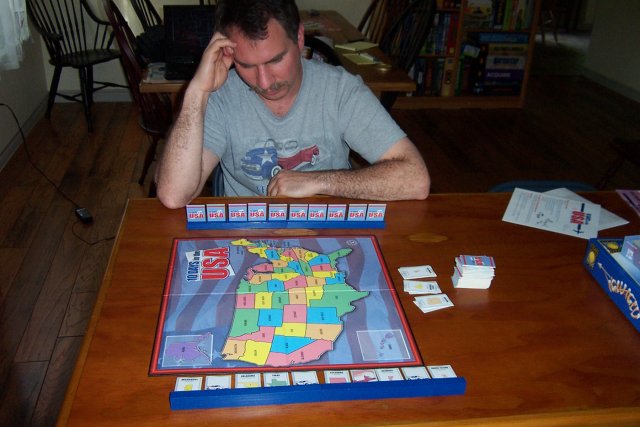
May 11, 2004Mother's Day Gamingby Susan Rozmiarek With it being Motherís Day this weekend, my family had to indulge me and play games. Not that I normally have to twist any arms to find players around here!
With it being Motherís Day this weekend, my family had to indulge me and play games. Not that I normally have to twist any arms to find players around here!
IQ-5We saw this game at the last Gulf Games where my son Shea spent quite a bit of time fooling with it. Itís the old familiar ďget x pieces in a rowĒ type of game but with a very interesting twist. The pieces are pellets, which each pellet being two halves of different colors, combos of red, yellow or blue. The board stands upright between players similar to Battleship and is comprised of holes or slots in which you slide the pellets. You can only see your side of the board and not your opponentís. On your turn, you slide in one of your pieces, so that one color is played on your opponentís side, and one color is on your side. The first player to get five in a row of a single color, horizontally, vertically or diagonally on his side of the board wins. Remembering where and what colors you placed on your opponentís board is key, but becomes more difficult as more and more pieces are played. Along with the memory element there is bluffing and a bit of deductive guessing, making the game quite fun and challenging.Shea is pretty good at this sort of thing and smoked me in our first game. He later played Ed and narrowly lost.
Iglu IgluThis is a new game by the Bruno pair, Faiduitti and Cathala. Itís a family game of Inuits hunting animals on melting ice. As one might expect from these two designers, there is quite a bit of chaos and luck in the game. But, there are also opportunities for some clever moves, too. What is particularly interesting is that rather than being a tile-laying game, it is a tile-UNlaying game. Instead of building the board as the game progresses, all the tiles are laid out facedown at the beginning of the game. On each turn, players must ďmeltĒ an unoccupied ice tile and remove it (in most cases). The hidden side of the tile contains an event. Some of events take place immediately and others are put aside to be used later. After melting an ice tile, The player then has three action points to spend on moving Inuits, building igloos, and hunting animals.The animals have a number on them that indicates how many action points it takes to defeat them. This number also represents how many victory points it is worth. Inuits must be on the same tile as an animal to defeat it or in the case of fish, on a tile adjacent to the fish. A polar bear can only be defeated by a harpoon. Inuits that canít defend themselves from a polar bear are removed to one of the corner spaces. Igloos, however, provide a hiding spot for its owner. There are several event tiles that can change the board during the game. An Ice Floe tile lets a player push a row of ice one space, along with anything on that ice. This can create new islands or join others. It can also move animals closer or further away from players. Another tile allows the player to sink a tile, sending any Inuits on it to one of the boardís corners. Other tiles move animals, give extra action points or provide a harpoon, the only weapon that will defeat a polar bear. Other tiles add animals and fish to the board. As the ice melts, islands will be formed. At the end of the game, the islands will be worth victory points for the players with the most Inuits and igloos (count as two Inuits) on them. The game ends when a player cannot melt an ice tile. Victory points from islands and defeated animals are counted up to determine the winner. Ed and I played a two-player game. Despite the high luck factor, we enjoyed it. The end of the game was especially tense, with us both trying to grab majorities of particularly valuable islands. There are a few variants on Bruno Faiduttiís website that are intended for more hardcore gamers. Iím looking forward to trying the game with those next. Also, Iíd like to try it with more players, although I expect it will be even more chaotic.
10 Days in the USAIíve been addicted to 10 Days in Africa lately despite being awful at it. Everyone keeps describing these games as being so light and Iím beginning to feel like an idiot. I decided to get the USA version thinking it would be less frustrating playing with familiar geography. I was right. I could just glance at the cards and know whether or not I was interested, without having to scrutinize the map so closely. It made for so much easier planning. Ed and I played two quick games and I actually won one!Iím planning to get all the games in this series. My kids enjoy it and will learn some geography, I hope. I wouldnít mind sharpening my own knowledge, particularly if Out of the Box Games publishes new versions with maps of Europe and the Middle East. I think I read somewhere that they were planning to do these.
Comments
Check out Expedition. It's a superb game for learning geography, the gameplay is excellent and you can pick it up pretty cheap. Posted by: Iain on May 12, 2004 3:46 AMHey Iain, great idea. I've got that game and it's an old favorite that hasn't been pulled out in a very long time. It hadn't occurred to me to play it with my kids. I sure wish there was a translation for the cards. Posted by: Susan on May 13, 2004 8:14 AMPost a comment
This page viewed E-mail Ed Rozmiarek with questions or problems concerning this page. Copyright © 2004, Ed & Susan Rozmiarek. |


